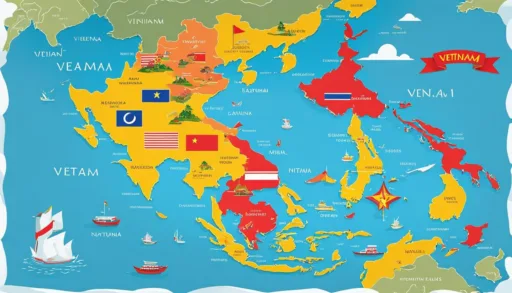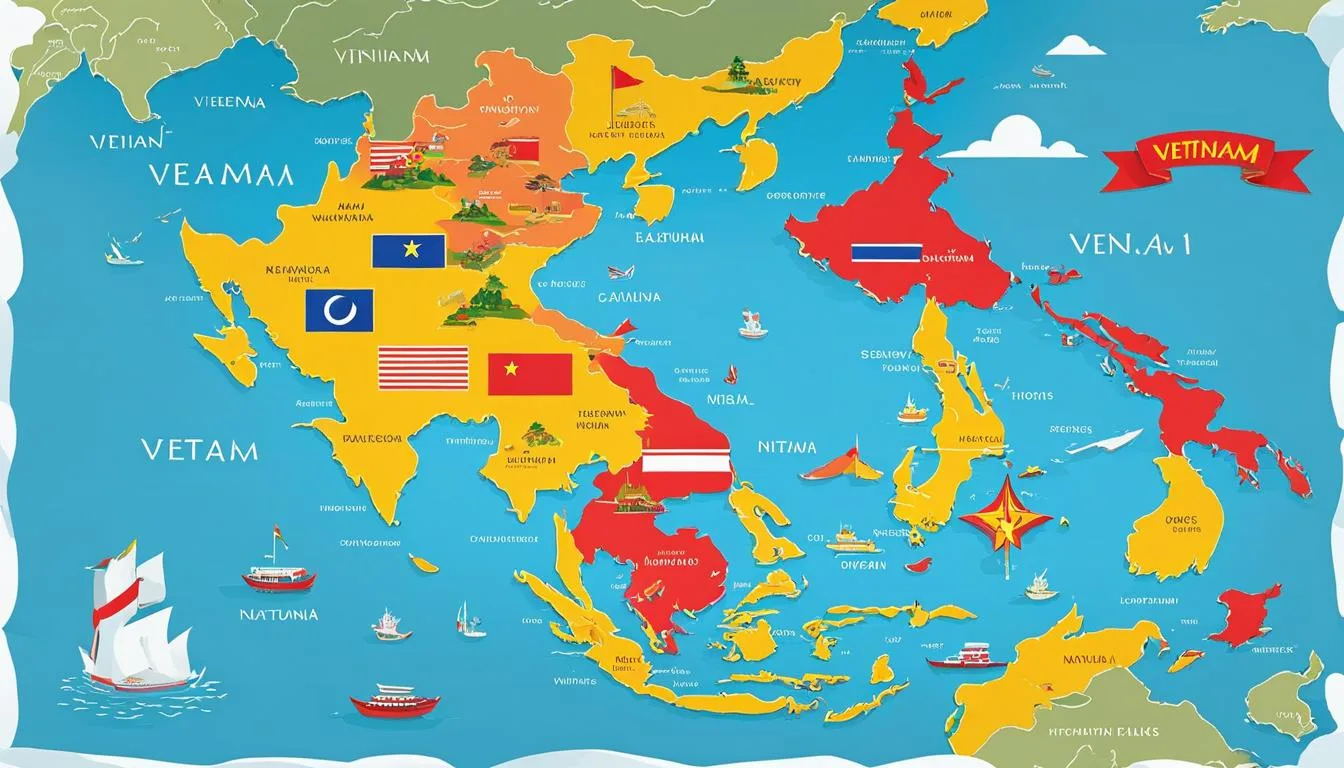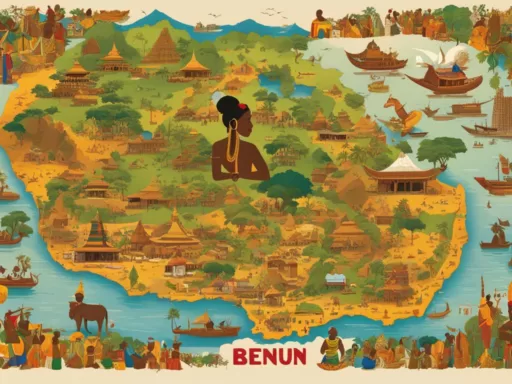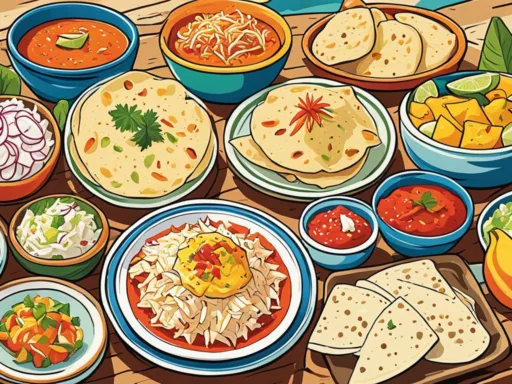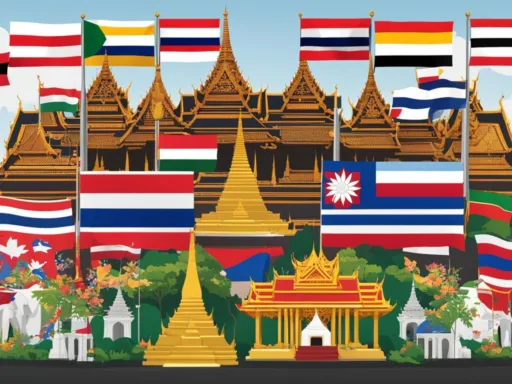Within the bustling streets and tranquil countryside of Vietnam, a remarkable figure emerges: over 110 languages spoken across the nation. This little-known fact encapsulates the staggering linguistic diversity of Vietnam. From the hills of Sapa to the deltas of the Mekong, this Southeast Asian country is not just about captivating landscapes or tantalizing cuisine; it’s also a vanguard of cultural and linguistic multiplicity. As the 8th most populous nation in Asia, Vietnam’s linguistic heritage is as rich as its history, with the Vietnamese language acting as the anchor amidst a sea of regional and ethnic variation.
The chronological odyssey of Vietnam’s language history is eternally woven into its socio-cultural fabric. From centuries of Imperial Chinese influence to the bends of French colonialism, each epoch has left an indelible imprint on the languages spoken in Vietnam. Today’s linguistic landscape in Vietnam is a vivid portrait that reflects its past trials and triumphs—a testament to its adaptability and resilience.
Key Takeaways
- Discover the sheer scale of Vietnam’s linguistic tapestry, with over 110 languages that accentuate the country’s cultural diversity.
- Explore the deep historical roots of the Vietnamese language, tracing its evolution through time and various cultural influences.
- Understand how Vietnam’s complex linguistic scene is intimately tied to its vibrant ethnic composition and dynamic history.
- Delve into Vietnam’s rich oral tradition, and how language offers a unique window into the heritage and ethos of its people.
- Uncover the multifaceted influences that have shaped the linguistic diversity Vietnam celebrates today.
- Experience the country’s linguistic unity amidst diversity, with Vietnamese serving as the vital connective thread for the nation.
A Glimpse into Vietnam’s Linguistic Landscape
Strolling through the bustling streets of Vietnam, one encounters a symphony of sounds that represents the country’s rich cultural tapestry. More than mere communication, each national language of Vietnam is a thread woven into the broader social fabric, reflecting an astonishing blend of history and modernity. With **ethnic groups in Vietnam** representing a multitude of languages, the nation is not just a geographic entity but a linguistic phenomenon.
Vietnamese is the binding agent of the country, yet the linguistic diversity is expansive, with over 110 recognized dialects and languages throughout the regions. Each of these languages plays a pivotal role in preserving unique cultural identities. This linguistic medley showcases Vietnam’s openness to cultural exchange, a testament to its history as a crossroads of civilizations and cultures
- Official Language: Vietnamese (Tiếng Việt) unifies the nation with its widespread use.
- Linguistic Inclusivity: Public signs and instructions often appear in both Vietnamese and English.
- Cultural Recognition: The government and institutions officially recognize 110 minority languages and dialects.
- Local and Tourist Engagement: Linguistic diversity caters to both residents and the growing influx of tourists.
The convergence of these distinct linguistic threads underlines Vietnam as a mosaic, intricate and ever-evolving. As each language carries its melody, the cumulative chorus is that of a nation rich in heritage and proud of its linguistic plurality.
The Official Language of Vietnam: Vietnamese
The Vietnamese language, or tiếng Việt, is not only the official language but also the heart of cultural identity in Vietnam. Belonging to the Austroasiatic language family, this rich language’s history and development tell a story of culture and conquest, making it an essential aspect of Vietnam’s heritage.
Origins and Evolution of Vietnamese
Rooted in the depths of northern Vietnam’s ancient societies, Vietnamese has evolved from the Viet–Muong languages, being shaped by intense historical influences. Both the might of Chinese rule and the sophistication of French governance have left indelible marks, introducing a plethora of loanwords that are still prevalent in modern Vietnamese vocabulary. A reflection of its storied past, Vietnamese stands today as a testament to its lineage among the language families of Vietnam.
Regional Variants of the Vietnamese Language
Despite its status as a national language, Vietnamese displays a tapestry of dialects regionally distinguished from each other. This linguistic variation illustrates the rich diversity found within Vietnam’s borders, painting an intriguing landscape of sound and syntax. Here, we explore the notable dialects that echo through the bustling cities of Hanoi, Hue, and Ho Chi Minh City.
The Vietnamese Writing System: From Chữ Nôm to Latin Script
The evolution of the Vietnamese writing system mirrors the cultural shifts that Vietnam has witnessed over the centuries. The ancient script Chữ Nôm, deeply intertwined with Chinese characters, laid the foundations for Vietnamese literature and folklore. However, the colonial era brought on a significant change, giving rise to the Vietnamese alphabet we see today—a product of Latin script adaptation that modernized the national communication system. Shouldering a similar responsibility, Vietnamese Braille ensures the language’s accessibility to all.
Let’s take a closer look at the historical progression of Vietnamese writing that has withstood the test of time:
| Period | Writing System | Notable Influence |
|---|---|---|
| Pre-Colonial | Chữ Nôm | Imperial Chinese Rule |
| Colonial Era | Latin-scripted Vietnamese alphabet (Quốc Ngữ) | French Colonial Governance |
| Modern Day | Latin-scripted Vietnamese alphabet and Vietnamese Braille | Accessibility and Education |
As the tables illustrate, from ancient scripts to todays’ globally recognized formats, the Vietnamese alphabets and dialects have not only survived but flourished, enabling the Vietnamese language to resonate with people from all walks of life, both domestically and around the world.
Linguistic Diversity: Ethnic Minority Languages in Vietnam
Vietnam’s rich tapestry of ethnic minority languages contributes significantly to the cultural and linguistic heritage of the country. Within this multilingual backdrop, three language families stand out for their historical significance and unique features that continue to influence the broader Vietnamese language family.
Preserving the Tai-Kadai Language Family
Among the ethnic minority languages in Vietnam, the Tai-Kadai language family holds a prominent place, with roots stretching deep into the northeastern territories adjacent to China. These languages retain their vibrancy through communities like the Tày and Nùng, who despite facing the influx of global languages, manage to preserve the linguistic purity and identity of their tongues. The Tai-Kadai family is an integral facet of the complex linguistic identity of the nation.
Understanding the Austroasiatic Influence
An equally vital presence within Vietnam’s linguistic diversity is the Austroasiatic languages. Central to this family is the Mường language, a linguistic sibling of Vietnamese, embedded in the lives of the Mường community in the northern highlands. Conveying a shared heritage through similar tonal patterns and an adapted script, Mường epitomizes the interconnectedness within the greater Vietnamese language family.
The Austronesian Imprint in Vietnamese Linguistics
The Austronesian family, another influential strand in the fabric of Vietnam’s ethnic minority languages, is represented by the Cham language. This language is an enduring echo from the ancient Champa civilization that once flourished on Vietnamese soil. Despite a dwindling number of speakers, the Cham language continues as a living symbol of the Austronesian family’s far-reaching cultural and linguistic legacy.
Tày: The Language of Vietnam’s Northeastern Frontier
The Tày language serves as the linguistical essence of Vietnam’s Tày ethnic group, an indigenous community predominantly residing in the country’s uneven, yet captivating, northeastern territories. Ingrained within the societal fabric of approximately 1.7 million people, Tày is not only a means of everyday communication but also a vessel carrying the rich cultural inheritance of the Tày people. The complexity of this language immerses one in the reflecting cultural nuances that pervade the agricultural and artisanal lifestyle intrinsic to the Tày community.
Boasting a collection of distinctive dialects, Tày language illustrates its diversity through subtle, yet meaningful, variations present across the regions. Each dialect comes as a linguistic mirror to the traditions and the environments in which it has developed. This has paved the way for a language system that is uniquely robust yet delicate in the intricacies that differentiate it from other Tai languages spread across Southeast Asia—in Laos, Cambodia, India, Myanmar, and China.
| Aspect | Description |
|---|---|
| Geographical Spread | Northeastern Vietnam, with speakers across the region’s rolling hills and valleys |
| Speakers | Approximately 1.7 million, primarily within the Tày ethnic group |
| Language Family | Tai language under the Tai-Kadai language family |
| Related Languages | Variants spoken in Laos, Cambodia, India, Myanmar, and China |
| Cultural Significance | Reflective of the Tày people’s agricultural customs and artisanal skills |
| Dialectical Richness | Diverse system of dialects within the language speaking community |
The vitality of the Tày language within Vietnamese culture cannot be understated. As the country prides itself on an unparalleled linguistic diversity, Tày stands as a fundamental component of ethnic groups Vietnam languages. It upholds a legacy that continues to resonate through the day-to-day life of its speakers, from paddy fields to craft markets, echoing the ancestry of the people and their tether to the land they inhabit.
“The Tày language is not merely a means of communication; it’s an ancestral echo that speaks of the vibrant culture and tenacity of Vietnam’s Tày community.”
- Interactive cultural exchange through language
- Preservation efforts for traditional dialects
- Enrichment of Vietnam’s linguistic landscape
Visiting the heart of Vietnam’s northeast, one witnesses the Tày language in its most authentic form—a living, breathing element that continuously molds the social and cultural identity of the Tày people. In its melodic tones and rural charisma, the language encapsulates a history seamlessly woven into the daily tapestry of lives led amidst the region’s natural splendor.

Mường: The Tongue of Vietnam’s Highlanders
The Mường language is a subtle yet powerful thread in the fabric of ethnic minority languages in Vietnam. Originating in the highlands of Hoa Binh and Thanh Hoa provinces, this Austroasiatic language serves as a lifeline for the cultural expression of the Mường people. With shared tonal qualities similar to the Vietnamese language, yet setting itself apart with a unique lexicon less influenced by Chinese elements, Mường enchants linguists and cultural enthusiasts alike.
Preservation efforts for Mường are not only about sustaining a language but also about nurturing the very essence of the Mường community’s identity. The language’s rich oral literature, including the enchanting narrative “Te t’c te ‘ác,” offers invaluable insights into the highlanders’ worldview, philosophy, and artistic heritage.
The Mường language does not merely communicate but also captivates with its rhythms and narrates profound stories from the verdant hills of Vietnam.
In comparing Mường with the broader spectrum of ethnic minority languages in Vietnam, one can understand the landscape of linguistic variation that is both complex and dynamic, contributing to the country’s rich cultural mosaic.
Linguistic initiatives aimed at documenting and promoting the Mường language are crucial. They ensure that future generations can access the cultural wealth embedded in every word, sentence, and story uniquely characteristic of Vietnam’s highlanders.
- Increased documentation of Mường linguistic practices
- Integration of Mường language in educational programs
- Preservation of oral traditions and folk literature in Mường
To ignore the value of the Mường language is to disregard an integral chapter of Vietnam’s history and cultural richness. As such, its study, preservation, and appreciation remain imperative for a comprehensive understanding of the region’s linguistic and cultural narratives.
Cham: A Language of Historical Significance
The Cham language, bearing the legacy of the mighty Kingdom of Champa, is a distinguished member of the Austronesian languages family in Vietnam. Its resilience and continued use in parts of Central Vietnam denote not just the perseverance of a language but also of the Cham people’s rich heritage that has weathered the tide of time.

Cham’s roots can be traced to the Malayo-Polynesian branch, making it an integral part of the broader Austronesian languages Vietnam is known for preserving. Despite being spoken by a relatively small community compared to other ethnic languages in Vietnam, Cham has not just survived; it has thrived as a beacon of cultural identity for its people.
With its unique dual dialictical framework, the Cham language is split into two main dialects: Eastern and Western Cham. Each one reflects the intricacies and nuances of the ancient Champa’s societal norms and practices.
| Feature | Eastern Cham | Western Cham |
|---|---|---|
| Geographical Distribution | Primarily in Vietnam | Spreads across Vietnam, Cambodia, and diaspora |
| Linguistic Influence | Heavily influenced by Vietnamese | Maintains more classical Cham elements |
| Writing System | Akrit and Eastern Cham script | Arabic-derived script |
| Cultural Significance | Used in religious and cultural ceremonies | Used in daily life and to maintain historical records |
The Cham language is more than just a communication medium for its speakers; it’s an anchor to their ancestry, connecting them to the fabled maritime empire of Champa that thrived between the 7th and 18th centuries.
Although now a minority, the Cham people and their language carry forward a legacy not only significant in the context of Austronesian languages in Vietnam but also as a testament to the country’s broader cultural and historical narrative.
Khmer in Vietnam: Beyond Cambodia’s Borders
The Khmer language is a vital part of the Southeast Asian linguistic landscape, extending its historical reach across the contemporary borders of Vietnam. Its presence is most prominently felt within the Khmer Krom community, an ethnic group residing primarily in the Mekong Delta. These individuals are descendants of the Angkor Empire and contribute to the rich tapestry of ethnic groups Vietnam languages. The linguistic traditions of the Khmer Krom stand as a testament to the endurance and evolution of the Khmer language amidst the diversity of regional dialects in Vietnam.
Beyond merely a means of communication, the Khmer language reflects the cultural and ceremonial life of its speakers in Vietnam. Festivals, folk music, and traditional rituals are expressed through this language, ensuring the ancient customs of the Khmer Krom are preserved and continue to flourish. Historical and religious texts, as well as contemporary schools, support the everyday use of Khmer, thus upholding it as a living language among other ethnic groups Vietnam languages.
| Linguistic Feature | Description |
|---|---|
| Language Family | Austroasiatic |
| Region | Mekong Delta, Vietnam |
| Speakers in Vietnam | Over 1 million |
| Writing System | Khmer script |
| Cultural Significance | Deeply tied to heritage and ceremonial practices |
| Educational Status | Taught in schools and used in religious texts |
The continued usage and teaching of the Khmer language within Vietnamese borders reflects a profound respect for cultural plurality and acknowledges the diverse history of the nation’s inhabitants. As Vietnam moves forward, the influence of its neighbors and its own multicultural citizens reshape the linguistic narrative. The survival and celebration of the Khmer language by the Khmer Krom are intrinsic to the country’s identity, spotlighting the importance of language as a vessel of history and a bridge between communities.
Chinese Dialects Amongst Ethnic Groups in Vietnam
The rich tapestry of Vietnam’s cultural heritage is highlighted by the presence of foreign languages Vietnam, including the array of Chinese dialects that continue to be spoken by the Chinese minority Vietnam. These dialects serve as a bridge, not only within the Chinese communities but also between different ethnic groups throughout the country, contributing to the polyglot nature of Vietnamese society.
In addition to Mandarin, which serves as a lingua franca amongst various Chinese communities, several other dialects have taken root in Vietnamese soil. Each dialect encapsulates links to history and tradition, underlying the complex socio-cultural interactions between Vietnam and China. Here is an overview of some of the prevailing Chinese dialects and where they are commonly spoken:
| Chinese Dialect | Regions Spoken | Notable Features |
|---|---|---|
| Cantonese (Yue) | Ho Chi Minh City, Southeast Vietnam | Cultural and culinary influence on local practices |
| Hokkien (Min Nan) | Central and Southern Vietnam, particularly Da Nang | Impact on local commerce and trade |
| Teochew (Chaozhou) | Vietnamese coastal cities | Preservation in family and community rituals |
| Hakka | Scattered enclaves throughout Vietnam | Maintenance of distinctive Hakka identity |
The ethnic diversity of Vietnam is augmented by the inclusion of these languages and dialects. It is not uncommon to hear the cadences of southern Cantonese or the melodic rise and fall of Hokkien in the bustling markets and intimate family gatherings, serving as a living museum of linguistic and cultural amalgamation.
Preserving these dialects is a key aspect of securing the tapestry of foreign languages Vietnam. Efforts by cultural institutions, alongside community initiatives, create spaces where the Chinese minority’s language and culture thrive, enhancing interaction and understanding between different ethnic groups in Vietnam.
The Tai–Kadai Language Family Within Vietnam: Nùng and Its Variations
The Tai-Kadai language family, a significant linguistic group in Southeast Asia, sees its robust continuity in Vietnam through the Nùng language. A rich tapestry woven from the very fabric of Northern Vietnamese culture, the Nùng dialects resonate amongst nearly a million speakers across the provinces of Cao Bang and Lang Son. This linguistic diversity exemplifies the intricate relationship between language and the traditions of those who speak it.
Within its sphere, Nùng does not stand alone and static but branches into several dialects, each serving a distinct voice of the Nùng community. Among these, Nuang Phan Slinh stands out, offering insights into the slight but telling regional variations of the language and its speakers who have threaded their history through the lanes of agriculture and time-honed craftsmanship.
- Cultural Significance: The Nùng language is not merely a means of communication but a vessel of cultural heritage, embodying the social practices and agricultural lifestyle of its speakers.
- Linguistic Diversity: A stroll through Nùng-speaking regions is a symphony of dialects, signifying the nuanced ways in which communities adapt and evolve their linguistic identities.
- Preservation Efforts: Language conservation is paramount, as the modern world encroaches upon the traditions and languages of smaller ethnic groups.
Linguists and cultural enthusiasts alike find the Nùng language an intriguing study of how language interfaces with ethnicity, geography, and the changing tides of socioeconomic demands. From its tonal sounds that echo the mountainous landscapes to the very words that carry centuries of customary legacy, the Nùng language is a testament to Vietnam’s unwavering bond to the Tai-Kadai family’s linguistic roots and a world that continually finds unity and identity in diversity.
H’Mông: A Distinct Dialectic Identity in Vietnam
The intricate weave of Vietnam’s linguistic traditions is highlighted by the unique presence of the H’Mông dialect. A member of the Hmong-Mien language family, the H’Mông language is a fabric of diverse dialects and rich cultural expressions. Recognized as a vital part of the nation’s identity, the H’Mông people’s linguistic patterns reflect the complexity and richness of the ethnic groups in Vietnam’s languages.

The H’Mông dialect is not a monolith; it displays a variety of dialectal forms, each with unique phonetic and grammatical nuances. These dialects offer insights into the adaptability and resilience of the H’Mông communities as they maintain language traditions amidst a sea of linguistic change.
| H’Mông Dialect | Region | Tone System | Phonetic Particularities |
|---|---|---|---|
| White H’Mông | Northern Vietnam | Seven-toned | Aspirated Consonants |
| Green H’Mông | Northern Vietnam | Six-toned | Nasal Vowel Endings |
| Black H’Mông | Northwest Vietnam | Eight-toned | Retroflex Sounds |
The H’Mông share cultural ties with other ethnic groups in Vietnam, yet their language serves as a powerful emblem of their distinct identity. Folklore, music, and traditional clothing styles are interlaced with the linguistic threads of their dialect, underscoring the symbiotic relationship between language and culture among Vietnam’s ethnic minorities.
The beauty of Vietnam’s linguistic diversity is epitomized in the rich tapestry of dialects like that of the H’Mông—an oral heritage that continues to resonate through the mountains of Vietnam.
Foreign Languages in Vietnam: Traces of Colonial and Global Influence
The intricate history of Vietnam is etched not just in its culture but also in its languages. The vibrant linguistic landscape here is peppered with remnants of its colonial past and influences from far-reaching corners of the globe. While numerous global languages are spoken today, certain foreign tongues have carved a niche in Vietnamese society.
French, a lasting vestige of colonial times, continues to exhibit its relevance even as Vietnam journeys through the 21st century. The French language in Vietnam, although no longer the lingua franca it once was, still retains a place of honor in academia and legal affairs, signifying a long-standing colonial influence on languages within the nation.
The Legacy of French in Modern Vietnam
France’s influence over Vietnam spanned several decades, instilling aspects of Gallic culture that persist to this day. From architecture to cuisine, the imprint is undeniable. Language, however, is arguably the most enduring colonial legacy. French still enjoys its status especially among the Vietnamese elite and elder generations, contributing to the linguistic diversity that distinguishes Vietnam. Moreover, interest in French is being revived with Vietnam’s participation in the International Organization of La Francophonie, a clear indication of the robustness of French language influence in Vietnam.
English and Other Foreign Languages Gaining Popularity
With globalisation, the English language permeates the daily life of Vietnamese citizens, emerging as an essential tool for international business, higher education, and tourism. English language influence in Vietnam has grown rapidly in recent years, becoming the dominant foreign language taught in schools and used in business settings. Furthermore, global languages from Europe, such as German and Russian, while less widespread, are part of the array of languages that students and professionals are increasingly learning to gain a competitive edge in the global market.
| Language | Historical Influence | Current Role in Vietnam |
|---|---|---|
| French | Colonial administration, education, and legal systems | Used in academia, by the older generation, and diplomatic engagements |
| English | Globalisation, international business | Primary foreign language in schools, business, and tourism |
| Other European Languages | Cultural exchanges, historical partnerships | Niche academic and professional fields; cultural studies |
Indeed, the proficiency in these global languages Vietnam boasts today highlights the open-mindedness of its people and the nation’s strategy towards integrating into the broader international community.
Conclusion
Delving into the linguistic diversity of Vietnam is akin to embarking on an exploratory journey through a dense tapestry of culture and history. At the forefront is the Vietnamese language—a symbol of national unity—, standing prominently among the myriad of languages spoken in Vietnam. Its widespread use not only reflects the nation’s identity but also marks the dominance of this Austroasiatic tongue in government, media, and everyday communication.
Beyond the dominant vernacular, the distinctive tongues of Vietnam’s ethnic minorities provide a fascinating study in contrast and variation. Each linguistic community embodies a unique piece of the nation’s soul, from the highlands of the Muong people to the historied whispers of the Cham language. This rich patina of regional tongues contributes to the country’s vibrant identity, offering a living mosaic of voices and experiences.
In reflecting on Vietnam’s comprehensive language portfolio—including the legacy of French and other foreign languages—what emerges is a narrative not just of a people and their communication methods, but of an evolving landscape where ancient roots and modern influences coalesce. Appreciating this melange of languages allows for a deeper connection with the Vietnamese spirit and an enhanced understanding of its energetic embrace of both tradition and progress.
